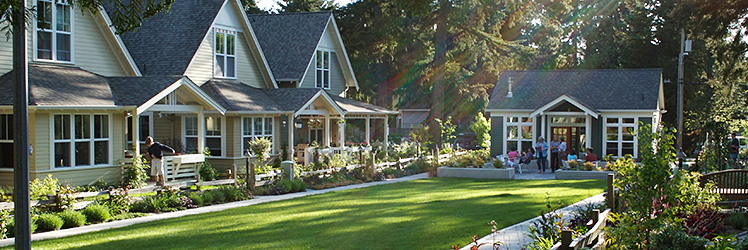Narrow streets idea for cities: a great idea that can't happen in already built places
Vox has a story ("Building streets for humans rather than cars could help solve the affordable housing crisis") about an interesting proposal from San Francisco by Steve Bombek of Narrow Streets SF, to add housing to the city by creating a new type of street network with people-focused streets--walkways and bike paths of say 15 feet in width--which would "create more land" available for redevelopment as presumably affordable housing.
 Posts on that blog include photos of various examples of narrow streets from other cities, mostly in Europe.
Posts on that blog include photos of various examples of narrow streets from other cities, mostly in Europe.There is also the "pocket neighborhoods" concept by Ross Chapin, which is an update of an older style of better using land within blocks.
And plenty of more modern examples, such as the Vauban neighborhood in Freiburg, Germany, where parking for automobiles is accommodated by a parking garage on the edge of the development ("In German Suburb, Life Goes on Without Cars," New York Times).
Matt Yglesias says it's unlikely because of the political difficulties, but the political difficulties aren't even the most significant factor.
In already built places, reconstructing neighborhoods and the street network is hyper costly. In already built areas, it is "impractical" read: completely and totally uneconomic to do this.
Image from Pocket Neighborhoods.
So the idea is really only applicable to empty sites--greenfield, grayfield, and brownfield--that have no housing now. And there are places in most cities where this could be/could have been done.
 Walking path, Vauban neighborhood, Freiburg, Germany. Image from the New York Times.
Walking path, Vauban neighborhood, Freiburg, Germany. Image from the New York Times. Most DC neighborhoods already have comparatively narrow streets.
For example the east-west streets in my neighborhood are mostly about 32 feet wide (the numbered streets going north-south are wider).
You'd have to convert 20 blocks worth of streets to recover a newly developable block of 300 feet in width.
Redeveloping 180 blocks would yield 9 "new" blocks for development.
But in order to do this, you have to tear down everything in between, because otherwise how do you recapture the newly recovered land?--unless you are going to build on 15 wide lots between the new curb and the existing sidewalk all you're doing is creating wide planting strips.
By densifying--tearing down two-story single family housing and replacing it with 6 story multiunit buildings, perhaps you could make this work financially, except that there isn't enough demand.
But the base cost of acquiring one block of houses would range from a minimum of about $21 million (32 houses, and people would want a premium in order to move) to $60 million (rowhouse blocks have an intermediary street and no backyards and total about 72 houses).
Plus, the cost to redo the streets and upgrade the water, sewer, and electricity infrastructure to accommodate more housing is another significant cost, maybe between $1 million and $3 million per block.
Not to mention the cost of building new housing at a minimum of $150 per square foot for new construction.
Chancellor's Row development by EYA off 7th Street NE in Brookland.
In any case, a form of this is happening already, but is more about cramming in more single family housing.
Because the cost of land in strong markets is so high, "new" single family housing when it is constructed, is mostly built with "zero lots" -- a planting strip in front and no backyard. But there is still a street network, albeit narrower.
The EYA Chancellors Row development in Brookland is an example of such a development, but there are many others.
Labels: urban design/placemaking






5 Comments:
Richard this is a very important idea and development that is long overdue. As I see things- DC's alleys could use some of this - not a total makeover- but certainly some of this approach could go towards refitting / retrofitting some alley areas to be more inviting and beautiful- sort of like ancient city areas where they never even had horse and buggy access. Problem with a lot of this is emergency access- if a fire happens there still needs to be firetruck access- this is of vital concern to any design like this- but somem of it certainly cloud be made to happen in DC's alleys- which now are mostly parking places for old people unwilling to take transit who are glued to their cars.
adding accessory dwelling units to extant houses is a lot cheaper and achievable. And yes, developing on the interior of old blocks that have interior block spaces-after 1900 it is rare to have blocks developed in that way.
On the nonrowhouse blocks in my neighborhood you can add ADUs to most, but not all, properties.
The narrow walkways idea should be done in places that are grayfield, and as I said in the post, in some respects, it's already happening, at least in strong markets.
it seems that for many ideas like this to come to reality we are going to have to wait for the old NIMBY car centric population to die off. These people will fight tooth and nail to keep alleys for parking and to keep out multiple use especailly any new residential. This is so sad because it will severely impact the housing shortage here in DC if ADUs could be built more easily int he city's alley areas.
well, yes, for ADUs. The problem otherwise is that we aren't in the position of being able to start from scratch and rebuild the city over completely.
Nice post.
Go here-pharmacy online
Post a Comment
<< Home